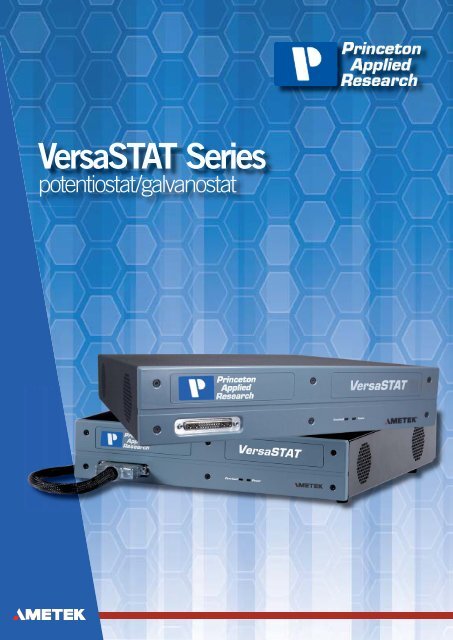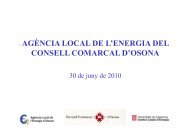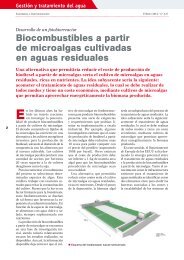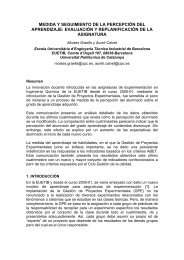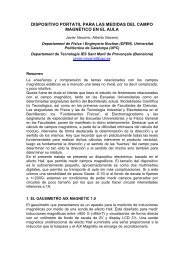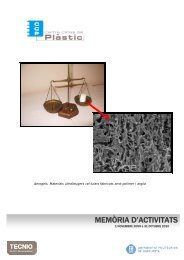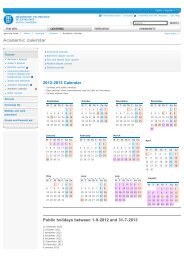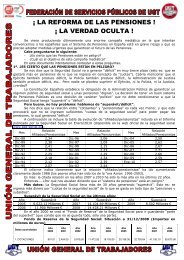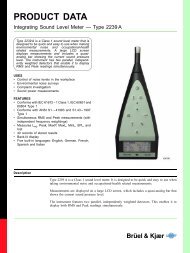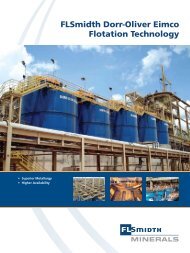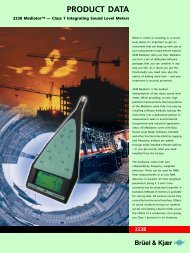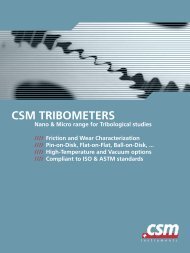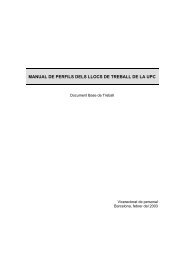VersaSTAT Series Brochure A4.indd - UPC
VersaSTAT Series Brochure A4.indd - UPC
VersaSTAT Series Brochure A4.indd - UPC
You also want an ePaper? Increase the reach of your titles
YUMPU automatically turns print PDFs into web optimized ePapers that Google loves.
<strong>VersaSTAT</strong> <strong>Series</strong><br />
potentiostat/galvanostat
Introducing...<br />
The <strong>VersaSTAT</strong><br />
<strong>Series</strong><br />
The <strong>VersaSTAT</strong> series is a completely<br />
new design of potentiostat / galvanostat,<br />
combining over forty years of Princeton<br />
Applied Research knowledge and<br />
expertise in the development of world<br />
leading electrochemical test products<br />
with advanced performance from the very<br />
latest measurement technology. This,<br />
together with easy to use, yet powerful<br />
PC software makes the <strong>VersaSTAT</strong><br />
series of instruments the best value<br />
electrochemical test systems on the<br />
market.<br />
Combining advanced measurement<br />
technology with user-friendly, yet powerful<br />
modular PC software, the <strong>VersaSTAT</strong> series<br />
potentiostat/galvanostat are a cut above for<br />
performance, versatility, and value...<br />
Versatile, easy to use VersaStudio<br />
software<br />
High Current and power booster options<br />
for electrodeposition, pulse-plating, and<br />
energy storage<br />
High speed DC measurement and<br />
experiment sequencing (e.g. for step/<br />
pulse analysis)<br />
Optional built-in frequency response<br />
analyzer providing fully integrated DC<br />
and EIS analysis<br />
<strong>VersaSTAT</strong> 3<br />
The more value oriented <strong>VersaSTAT</strong> 3 provides most<br />
of the capabilities you need in your laboratory. This<br />
versatile potentiostat / galvanostat is performance<br />
driven allowing for use in many different applications<br />
including Corrosion, Energy Storage, Sensors,<br />
Electrodeposition, and Research Electrochemistry.<br />
Electrochemical techniques provided by the<br />
<strong>VersaSTAT</strong> 3 that are widely used in corrosion<br />
applications include Linear Polarization Resistance<br />
(LPR), Electrochemical Impedance Spectroscopy<br />
(EIS), and EIS at various polarization levels.<br />
The new VersaStudio software is included with all<br />
<strong>VersaSTAT</strong> 3 systems. Systems are provided for a<br />
range of voltammetry and corrosion applications.<br />
The following groups of techniques are available:<br />
Corrosion providing multiple corrosion analysis<br />
techniques such as LPR, Tafel etc<br />
Voltammetry providing basic and advanced scan,<br />
step and pulse electrochemical techniques<br />
Impedance may be added to any system to<br />
provide electrochemical impedance spectroscopy<br />
techniques<br />
±650mA / ±10V polarization range as standard<br />
- ideal for many electrochemical applications<br />
including corrosion, sensors and biomedical<br />
±2A high current option and boosters up to 20A<br />
for battery, fuel cell or electroplating applications<br />
Excellent current measurement resolution for<br />
corrosion, coatings and micro-electrode analysis<br />
An internal frequency response analyzer option<br />
that provides impedance analysis over the<br />
frequency range 10µHz to 1MHz<br />
The impressive combination of the<br />
performance and versatility makes the<br />
<strong>VersaSTAT</strong> series a tremendous value for<br />
researchers and scientists.
<strong>VersaSTAT</strong> 3 specifications<br />
Configuration<br />
Cell connections<br />
Data acquisition<br />
Data acquisition<br />
Time base resolution (minimum)<br />
Automatic noise filters<br />
Power amplifier (CE)<br />
Voltage compliance<br />
Current compliance<br />
Potentiostat bandwidth<br />
Stability settings<br />
Slew rate<br />
Rise time (-1.0V to +1.0V)<br />
Voltage control (potentiostat mode)<br />
Applied voltage range<br />
Applied voltage resolution<br />
Applied voltage accuracy<br />
Maximum scan rate<br />
Maximum scan range / resolution<br />
Current control (galvanostat mode)<br />
Applied current range<br />
Applied current resolution<br />
Applied current accuracy<br />
2, 3 or 4 terminal plus ground<br />
3 x 16-bit 500k samples per second ADCs<br />
synchronized - voltage / current / auxiliary<br />
10µs (100k samples / second)<br />
Enabled / disabled<br />
± 12V<br />
± 650mA (standard)<br />
± 2A (with 2A option)<br />
1 MHz<br />
high-speed, high-stability<br />
≥ 8V per µs typical (no load)<br />
The <strong>VersaSTAT</strong><br />
<strong>Series</strong><br />
Hardware<br />
The VersaStat series are not simply updates<br />
to previous <strong>VersaSTAT</strong> instruments, they are a<br />
completely new design that makes use of the latest<br />
generation of RISC processor devices to provide<br />
the speed, versatility and precision required for<br />
electrochemical applications, but at a lower cost.<br />
The system requires the minimum of installation<br />
set-up, being controlled from a PC via its standard<br />
Universal Serial Bus USB connection and utilizing<br />
“plug and play” technology to get the system up and<br />
running, fast...<br />
The VersaStat series utilize high-speed digital to<br />
analog converter circuitry, providing instantaneous<br />
step changes and pulses to generate the most<br />
complex potentiostatic / galvanostatic waveforms.<br />
Three high-speed, (500ksamples / second) analog<br />
to digital converters provide fully synchronized<br />
measurements of the cell voltage, cell current and<br />
auxiliary voltage input.<br />
The units provide 4-terminal cell connections, which<br />
allows great flexibility for the analysis of both high and<br />
low impedance cells. In low impedance applications,<br />
errors due to cell connection cable impedance may<br />
adversely affect the accuracy of results. The use of<br />
4-terminal connections, allows the cell voltage to be<br />
measured at the cell terminals, minimizing errors due<br />
to cable impedance. For high impedance cells (e.g.<br />
in corrosion applications) where the voltage drop in<br />
the CE / WE connections is small compared to the<br />
impedance of the cell, 3-terminal connections are<br />
also available.<br />
An auxiliary voltage input is also provided for<br />
connection to external devices. The measurements<br />
taken from this input are synchronized to the cell<br />
voltage and current measurements, allowing the<br />
auxiliary input to be used in many applications,<br />
including measurements from pH meters,<br />
temperature sensors and optical sensors.<br />
The VersaStat series provide an optional built-in<br />
frequency response analyzer (FRA) that is able<br />
to characterize a wide range of electrochemical<br />
cells. The FRA is fully integrated into the system<br />
allowing high speed switching between DC and EIS<br />
measurements.<br />
<strong>VersaSTAT</strong> 4<br />
The <strong>VersaSTAT</strong> 4 builds upon the already impressive<br />
new design of the <strong>VersaSTAT</strong> 3 giving you even more<br />
improved speed, versatility, and precision required<br />
for a range of electrochemical applications.<br />
The increased maximum current of 1A standard, as<br />
well as optional current boosters up to 20 A, positions<br />
the <strong>VersaSTAT</strong> 4 to take you from the early stages<br />
of battery and fuel cell development to the charge/<br />
discharge experiments on the final product and the<br />
challenges that lie ahead for the next generation of<br />
batteries.<br />
The improved low current performance with fA<br />
resolution and pA accuracy addresses current<br />
sensitive applications such as sensors, corrosion<br />
inhibitors, and combined with the optional FRA,<br />
coating technologies. The additional analog filtering<br />
makes the <strong>VersaSTAT</strong> 4 an even better choice for<br />
corrosion applications while the additional bandwidth<br />
filtering adds extra stability for capacitive cells. The<br />
<strong>VersaSTAT</strong> 4, with its added capabilities, makes an<br />
exciting addition to our <strong>VersaSTAT</strong> family making<br />
them even more of an exceptional value for all of<br />
your application needs.<br />
Improved low current performance with fA<br />
resolution and pA accuracy<br />
Maximum current up to 1A with additional booster<br />
options from 2A-20A<br />
2 µs time base for faster data acquistion and<br />
faster scan rates<br />
Additional analog filter selections on current<br />
and voltage channels for superior signal/noise<br />
measurements<br />
Additional bandwidth filtering options for greater<br />
stability on capacitve cells<br />
An internal frequency response analyzer option<br />
that provides impedance analysis over the<br />
frequency range 10µHz to 1MHz<br />
Easy-to-use VersaStudio software included<br />
The <strong>VersaSTAT</strong> 4 provides a lower cost, simple to<br />
use, yet powerful electrochemical test system that is<br />
equally capable for routine electrochemical research<br />
and for educational / teaching requirements.<br />
The software is fully featured to allow complex<br />
experiments to be set-up and run but is simple<br />
to operate for the novice user. The full range of<br />
support and technical help available from Princeton<br />
Applied Research makes this the ideal product for<br />
educational applications.
<strong>VersaSTAT</strong> 4 specifications<br />
Configuration<br />
Cell connections<br />
Data acquisition<br />
Data acquisition<br />
Time base resolution (minimum)<br />
Automatic noise filters<br />
Power amplifier (CE)<br />
Voltage compliance<br />
Current compliance<br />
Potentiostat bandwidth<br />
Stability settings<br />
Slew rate<br />
Rise time (-1.0V to +1.0V)<br />
Voltage control (potentiostat mode)<br />
Applied voltage range<br />
Applied voltage resolution<br />
Applied voltage accuracy<br />
Maximum scan rate<br />
Maximum scan range<br />
Current control (galvanostat mode)<br />
Applied current range<br />
Applied current resolution<br />
Applied current accuracy<br />
Windows is a registered trade mark of Microsoft Corporation.<br />
Specifi cations subject to change.<br />
2, 3 or 4 terminal plus ground<br />
3 x 16-bit 500k samples per second ADCs<br />
synchronized - voltage / current / auxiliary<br />
2µs (500k samples / second)<br />
Enabled / disabled<br />
± 12V<br />
± 1A (standard)<br />
± 2A (with 2A option)<br />
1 MHz<br />
six settings; high stability, 1 MHz-100Hz<br />
≥ 8V per µs typical (no load)<br />
The <strong>VersaSTAT</strong><br />
<strong>Series</strong><br />
Our Markets<br />
Sensors<br />
Corrosion<br />
Energy Storage<br />
Electrodeposition<br />
<strong>VersaSTAT</strong> 3F<br />
The <strong>VersaSTAT</strong> 3F is the latest addition to the<br />
<strong>VersaSTAT</strong> family. Although sharing similar<br />
specifications to the <strong>VersaSTAT</strong> 3 (10µs data<br />
acquisition, +/-650mA current range) and the<br />
<strong>VersaSTAT</strong> 4 (4nA lower current range, enhanced<br />
filtering options), the <strong>VersaSTAT</strong> 3F was designed<br />
specifically to operate with earth-grounded cells.<br />
The “F” in the <strong>VersaSTAT</strong> 3F name is for “floating,”<br />
a term used to describe the electrical isolation of the<br />
systems electrode leads and rear panel connectors<br />
from earth ground. In floating mode, the internal<br />
ground of the <strong>VersaSTAT</strong> 3F (as well as the cell leads<br />
and external connections at the rear panel) is allowed<br />
to float with respect to earth ground which allows it to<br />
operate with these grounded cells. Examples of earth<br />
grounded cells include autoclaves, strain apparatus,<br />
storage tanks and pipelines, and additional<br />
electrodes connected to a separate potentiostat that<br />
is not floating<br />
The <strong>VersaSTAT</strong> 3F was designed to operate in<br />
either a “normal” mode (same mode as V3 and<br />
V4 models) or a “floating” mode, selectable in<br />
the operating software. In addition to the mode<br />
selections, the <strong>VersaSTAT</strong> 3F also provides additional<br />
filters that could be required with some cells in<br />
order to enhance the signal to noise. A special<br />
“Notch Filter” for those frequencies associated with<br />
line power (50/60Hz), and “EIS Filters” (for those<br />
systems equipped with the FRA option) are available<br />
as needed.<br />
Capable of “floating” for operation with grounded<br />
cells and electrodes<br />
Specialized filters for float mode operation for<br />
enhanced signal/noise ratio<br />
±650mA / ±10V polarization range as standard<br />
- ideal for many electrochemical applications<br />
including corrosion, sensors and biomedical<br />
An internal frequency response analyzer option<br />
that provides impedance analysis over the<br />
frequency range 10µHz to 1MHz<br />
Additional bandwidth filtering options for greater<br />
stability on capacitve cells<br />
Easy-to-use VersaStudio software included<br />
Research<br />
Electrochemistry
<strong>VersaSTAT</strong> 3F specifications<br />
Configuration<br />
Cell connections<br />
Data acquisition<br />
Data acquisition<br />
Time base resolution (minimum)<br />
Automatic noise filters<br />
Power amplifier (CE)<br />
Voltage compliance<br />
Current compliance<br />
Potentiostat bandwidth<br />
Stability settings<br />
Slew rate<br />
Rise time (-1.0V to +1.0V)<br />
Voltage control (potentiostat mode)<br />
Applied voltage range<br />
Applied voltage resolution<br />
Applied voltage accuracy<br />
Maximum scan rate<br />
Maximum scan range / resolution<br />
Current control (galvanostat mode)<br />
Applied current range<br />
Applied current resolution<br />
Applied current accuracy<br />
2, 3 or 4 terminal plus ground<br />
3 x 16-bit 500k samples per second ADCs<br />
synchronized - voltage / current / auxiliary<br />
10µs (100k samples / second)<br />
Enabled / disabled<br />
± 12V<br />
± 650mA (standard)<br />
± 2A (with 2A option)<br />
1 MHz<br />
six settings; high stability, 1MHz-100Hz<br />
≥ 8V per µs typical (no load)<br />
VersaStudio software<br />
The complete VersaStudio software provides<br />
full access to the capabilities of the instrument,<br />
including the high current option and power booster<br />
when present. Various systems combining hardware<br />
and the VersaStudio software are provided to focus<br />
on particular application areas and to minimize cost.<br />
Systems may be upgraded at any time as budget<br />
becomes available or as requirements change.<br />
An impressive list of corrosion and electrochemical<br />
experiment types are provided that can be run<br />
individually or combined in powerful experiment<br />
sequences.<br />
There are four <strong>VersaSTAT</strong> systems available, each of which include VersaStudio software:<br />
<strong>VersaSTAT</strong>100 basic DC voltammetry techniques<br />
<strong>VersaSTAT</strong>200 advanced DC voltammetry techniques<br />
<strong>VersaSTAT</strong>300 DC corrosion techniques<br />
<strong>VersaSTAT</strong>400 complete DC voltammetry and corrosion techniques<br />
Impedance facilities may be added to any of these systems as a factory fit option<br />
Corrosion<br />
Voltammetry<br />
Impedance<br />
The corrosion system (<strong>VersaSTAT</strong>-300<br />
and -400) provides a range of DC<br />
electrochemical measurement techniques<br />
that are of particular importance for the<br />
corrosion scientist investigating coatings,<br />
rebar corrosion, inhibitors, biomedical<br />
implants etc. These techniques include:<br />
Potentiostatic, galvanostatic,<br />
potentiodynamic and galvanodynamic<br />
techniques<br />
Tafel and Rp fi tting analysis – providing<br />
the determination of corrosion current<br />
(Icorr), polarization resistance (Rp),<br />
data interpretation and corrosion rate<br />
calculations<br />
IR compensation for minimizing<br />
experimental errors due to solution<br />
resistance (Rs)<br />
Impedance analysis may also be added<br />
(Impedance module)<br />
The advanced voltammetry systems<br />
(<strong>VersaSTAT</strong>-200 and –400) provide a<br />
range of scan, step and pulse techniques<br />
that are of importance in analytical<br />
electrochemistry, microelectrode studies,<br />
sensor research, electrodeposition<br />
and battery/fuel cell analysis. A basic<br />
voltammetry system (-100) is also<br />
available that provides some of the<br />
fundamental techniques as a low cost<br />
alternative. The advanced system<br />
includes:<br />
Normal and differential pulse<br />
voltammetry - used in analytical<br />
electrochemistry applications e.g. for<br />
trace metal analysis<br />
Recurrent pulse techniques - used in<br />
battery / fuel cell analysis (including<br />
equivalent series resistance ESR<br />
analysis and GSM / CDMA mobile<br />
phone pulse test applications). Also<br />
used in electrodeposition applications<br />
Chronoamperometry and<br />
chronopotentiometry used in many<br />
electrochemical applications<br />
Automatic sequencing and looping<br />
of techniques for more advanced<br />
applications such as charge / discharge<br />
cycling of batteries for cell-life<br />
investigation<br />
Control of power booster options<br />
for testing high power cells for<br />
electrodeposition and energy storage<br />
applications<br />
Impedance analysis may also be added<br />
(Impedance module)<br />
Electrochemical Impedance Spectroscopy<br />
(EIS) capabilities may be added to any<br />
of the <strong>VersaSTAT</strong> systems as a factory<br />
fi t option. This provides a range of fully<br />
integrated techniques for studying the<br />
impedance of electrochemical cells,<br />
sensors, batteries / fuel cells, corrosion /<br />
coatings etc.<br />
Potentiostatic EIS - widely used for the<br />
analysis of electrochemical, battery and<br />
corrosion cells providing information on<br />
electrode kinetics, diffusion and mass<br />
transfer<br />
Galvanostatic EIS - particularly useful<br />
for characterizing batteries and fuel<br />
cells under DC current load conditions<br />
EIS analysis of batteries and fuel cells<br />
using the high current (2A) option or<br />
external power boosters<br />
Automatic charge / discharge / EIS<br />
experiment sequencing for battery,<br />
supercapacitor and fuel cell lifetime<br />
investigations<br />
Automatic sequencing of loop, EIS<br />
and delay steps to investigate trends<br />
of impedance over time, (e.g. the<br />
development of corrosion induced<br />
defects in a coating)<br />
Automatic sequencing of EIS and<br />
linear polarization resistance (LPR)<br />
techniques to verify corrosion rate data<br />
and to provide impedance analysis of<br />
corrosion mechanisms
<strong>VersaSTAT</strong>-100<br />
<strong>VersaSTAT</strong>-200<br />
<strong>VersaSTAT</strong>-300<br />
<strong>VersaSTAT</strong>-400<br />
General software facilities<br />
Open Circuit<br />
Linear scan voltammetry<br />
Corrosion Voltammetry<br />
EIS<br />
*<br />
*<br />
*<br />
*<br />
*<br />
*<br />
*<br />
*<br />
Cyclic voltammetry (single)<br />
Cyclic voltammetry (multiple cycles)<br />
Staircase linear scan voltammetry<br />
Staircase cyclic voltammetry (single)<br />
Staircase cyclic voltammetry<br />
(multiple cycles)<br />
Chronoamperometry<br />
Chronopotentiometry<br />
Chronocoulometry<br />
Fast Potential Pulses<br />
Fast Galvanic Pulses<br />
Recurrent potential pulses<br />
Recurrent galvanic pulses<br />
Square wave voltammetry<br />
Differential pulse voltammetry<br />
Normal pulse voltammetry<br />
Reverse normal pulse voltammetry<br />
Zero resistance ammeter (ZRA)<br />
Galvanic Corrosion<br />
Cyclic Polarization<br />
Linear Polarization<br />
Tafel<br />
Potentiostatic<br />
Potentiodynamic<br />
Galvanostatic<br />
Galvanodynamic<br />
Dynamic IR<br />
Potentiostatic EIS<br />
Galvanostatic EIS<br />
Loop<br />
The <strong>VersaSTAT</strong> software modules make use of core<br />
facilities that provide everything you would expect<br />
from a high quality electrochemical test system:<br />
Flexible experiment setup that can automatically<br />
sequence the potentiostatic, galvanostatic<br />
and impedance capabilities of the <strong>VersaSTAT</strong><br />
hardware<br />
Result displays and overlays in a wide variety of<br />
axis formats for DC and EIS experiments<br />
Voltage and current vs. time strip chart display<br />
Full storage and retrieval facilities allow straightforward<br />
comparison of current and stored data<br />
DC data analysis and fitting routines including<br />
line, Tafel and polarization resistance (Rp)<br />
Data output in text format into other applications<br />
for further analysis and report generation<br />
Line and circle fitting for basic EIS data analysis,<br />
for estimation of cell parameters such as solution<br />
resistance and polarization resistance<br />
Comprehensive EIS analysis and fitting techniques<br />
are available by importing data into the popular<br />
ZSimpWin option package. A range of equivalent<br />
circuits are pre-programmed in ZSimpWin and<br />
additional circuits may easily be added as<br />
required<br />
The software provides a comprehensive range<br />
of facilities, yet is incredibly easy to use. Basic<br />
experiments such as cyclic voltammetry are up and<br />
running with surprisingly few menu entries. This<br />
makes the system very easy for novice users.<br />
Using the carefully designed menus, even<br />
complicated experimental sequences, (e.g. battery<br />
charge / pulse discharge / EIS or multi-step<br />
electrochemical applications), are simple and logical<br />
to set up.<br />
Time Delay<br />
Sequence<br />
Message Prompt<br />
Measure OC<br />
Auxiliary Interface<br />
Run External Application<br />
DAC Output Control<br />
Condition<br />
Pre-experiment<br />
Deposition<br />
Equilibration<br />
Purge<br />
iR Determination<br />
EIS capability (Impedance) is optionally<br />
*<br />
available with any of these systems
Applications<br />
Corrosion Research<br />
The worldwide cost of corrosion is estimated at billions of<br />
dollars per year and represents several percent of GDP<br />
for most industrial countries. Corrosion affects our lives in<br />
many ways, causing safety and maintenance problems<br />
in bridges, buildings, pipelines, aircraft, automobiles and<br />
household goods. Investigation into improved coatings,<br />
inhibitors and alloys continues to combat the devastating<br />
cost of corrosion but more research is needed.<br />
Salt spray / coupon tests continue to be widely used<br />
in the investigation of corrosion phenomena. However,<br />
these tests typically take months to obtain information<br />
and are useless for investigating time-varying effects.<br />
By comparison, electrochemical test instrumentation<br />
(using potentiodynamic and galvanodynamic techniques)<br />
is able to obtain accurate results in a very short time<br />
period, allowing, for example, real-time monitoring of the<br />
performance of coatings and corrosion inhibitors.<br />
Electrochemical techniques provided by our instruments<br />
that are widely used in corrosion applications include:<br />
Linear polarization resistance (LPR) and Tafel analysis<br />
– providing measurement of corrosion current (Icorr),<br />
polarization resistance (Rp) and corrosion rate<br />
Cyclic Polarization - providing a way to study localized,<br />
pitting corrosion<br />
Electrochemical impedance spectroscopy (EIS)<br />
- providing fast, non-destructive characterization of<br />
corrosion phenomena and verification of Rp and<br />
corrosion rate data obtained by LPR<br />
EIS at various polarization levels - providing impedance<br />
information relating to different corrosion regimes such<br />
as passivation and pitting<br />
Battery, Fuel Cell and<br />
Supercapacitor Research<br />
Fuel cells offer the prospect of cleaner, more<br />
environmentally friendly energy sources for the<br />
future and research continues to be a priority for<br />
these devices. The development of micro fuel cells<br />
for mobile communications and PC applications<br />
is an exciting new application of this technology.<br />
Supercapacitors continue to be developed for<br />
instantaneous high power applications. New<br />
technology ultra-thin / ultra-flexible batteries are<br />
being developed for smart-card and intelligent paper<br />
applications.<br />
Research electrochemistry<br />
Research electrochemistry is a broad subject that<br />
covers many areas of investigation and therefore<br />
requires flexible test equipment that can be easily<br />
adapted to the requirements.<br />
High current options may be added as the<br />
requirement grows, so whether the application<br />
involves electrodeposition or pulse-plating our<br />
instruments remain the ideal choice. With our wide<br />
selection of measurement techniques, our<br />
instruments provide the range of capabilities that<br />
are needed to cover the diverse requirements of a<br />
modern research laboratory.<br />
Sensors<br />
Sensors are an integral part of our daily lives,<br />
and Princeton Applied Research systems have<br />
been utilized in research that brought many of<br />
these sensors to market. Sensors for glucose<br />
measurement to assist diabetics in controlling<br />
their blood glucose levels are just one of the many<br />
sensor applications that have been advanced by<br />
research utilizing our potentiostats/galvanostats.<br />
Be it potentiometric voltametric, gas, or biological<br />
sensors, the development and utilization of these<br />
as transducers continue to expand, and you can<br />
count on our systems to provide the capabilities and<br />
performance that researchers need to refine these<br />
life-enhancing devices.<br />
Biomedical applications<br />
DC corrosion analysis techniques are used to<br />
investigate the corrosion susceptibility of metallic<br />
biomedical implant devices such as artificial hips,<br />
orthopedic screws / rods and prosthetics. New<br />
alloys and implant techniques are continually being<br />
developed but corrosion still causes cracks and<br />
fractures in load bearing implants and inflammation<br />
due to corrosion products being deposited in the<br />
surrounding tissue.<br />
Our instruments are ideal for running test standards<br />
such as the ASTM F2129 “Standard Test Method<br />
for Conducting Cyclic Potentiodynamic Polarization<br />
Measurements to Determine the Corrosion<br />
Susceptibility of Small Implant Devices” that are<br />
widely used in this application.
<strong>VersaSTAT</strong> ordering information<br />
Hardware<br />
Options Model Number Model Number Model Number<br />
2A high current option 2A / <strong>VersaSTAT</strong>3 2A / <strong>VersaSTAT</strong>4 2A / <strong>VersaSTAT</strong>3F<br />
FRA option FRA / <strong>VersaSTAT</strong>3 FRA / <strong>VersaSTAT</strong>4 FRA/<strong>VersaSTAT</strong>3F<br />
Advanced auxiliary interface AAI / <strong>VersaSTAT</strong>3 AAI / <strong>VersaSTAT</strong>4 AAI/<strong>VersaSTAT</strong>3F<br />
Power Boosters compatible with the <strong>VersaSTAT</strong> <strong>Series</strong><br />
8A / 50V* 8A / <strong>VersaSTAT</strong>3 8A / <strong>VersaSTAT</strong>4 8A / <strong>VersaSTAT</strong>3F<br />
10A / 20V* 10A / <strong>VersaSTAT</strong>3 10A / <strong>VersaSTAT</strong>4 10A / <strong>VersaSTAT</strong>3F<br />
20A / 20V* 20A / <strong>VersaSTAT</strong>3 20A / <strong>VersaSTAT</strong>4 20A / <strong>VersaSTAT</strong>3F<br />
Cell Accessories<br />
K0047<br />
K0235<br />
K0264<br />
RDE0018<br />
Corrosion Cell Kit<br />
Corrosion Flat Cell<br />
Micro-Cell Kit<br />
Analytical Cell Kit<br />
Ancillary Equipment<br />
303A Static Mercury Drop Electrode †<br />
507 Interface for model 303A<br />
QCM922<br />
Quartz Crystal Microbalance<br />
616 Rotating Disk Electrode<br />
636 Rotating Ring-Disk Electrode<br />
Systems<br />
The following systems all include VersaStudio<br />
software:<br />
<strong>VersaSTAT</strong>x 100 Basic DC electrochemistry system<br />
<strong>VersaSTAT</strong>x 200 DC electrochemistry system<br />
<strong>VersaSTAT</strong>x 300 DC corrosion system<br />
<strong>VersaSTAT</strong>x 400 Full capability DC system<br />
x= model of potentiostat<br />
Impedance capability may be added to any of the<br />
above systems by ordering the FRA option<br />
*Bandwidth reduced with addition of current boosters<br />
† HDME and DME modes only<br />
Extended Warranty available: One-year warranty<br />
included with the purchase, additional years<br />
can be added. Includes labor, materials and<br />
return shipping.
www.princetonappliedresearch.com<br />
pari.info@ametek.com<br />
USA<br />
801 South Illinois Avenue<br />
Oak Ridge<br />
TN 37831-0895 USA<br />
Tel: (865) 425-1289<br />
or (865) 482-4411<br />
Fax: (865) 481-2410<br />
Europe<br />
Unit B1 Armstrong Mall<br />
Southwood Business Park<br />
Farnborough<br />
Hampshire GU14 ONR UK<br />
Tel: +44 (0)1252 556800<br />
Fax: +44 (0)1252 556899<br />
Please see our website for a complete list of<br />
our global offices and authorized agents


